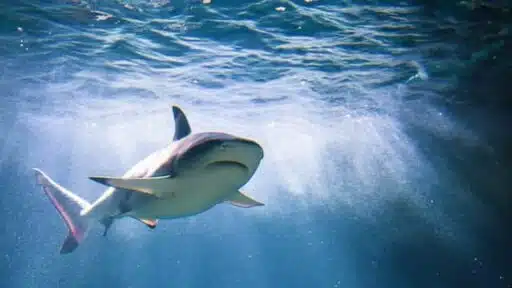Sharks are aquatic predators, and it’s very normal to keep an eye open for them when you plan to visit Virginia Beaches.
Several different species of sharks reside in the Hampton Roads region. Moreover, some swim only a few feet inland from the coast.

Normally, people hesitate before entering the ocean at the beach because of shark attacks. A recent series of incidents at Virginia Beach has startled many people.
There have been several shark attacks that resulted in severe casualties, even death in some cases. The ratio of these attacks has increased significantly over the past few years.
More Shark Attacks in Virginia
The number of shark attacks in Virginia appears to be rising. However, authorities continue to convince the public that such accidents are rare.
Yet, encounters between tourists and these dangerous ocean predators still happen. Every year, news reports surface concerning shark attacks. And it appears that shark attacks are making more news nowadays than ever.
Studies indicate that they have practically doubled in the last 20 years. However, the increase is probably a result of coastal development.
Additionally, more people swimming correlates with an increase in shark populations. Hence, there is a higher chance of being near a shark.
As you get further south, attacks and sightings do rise a little. It is a result of warmer water and greater shark-feeding sources.
Sharks That Can Be Found in Virginia
Virginia is home to several different breeds of sharks. Several different shark species exist here. Off the shore of Virginia Beach, you can often see these sharks:
1. Sandbar Shark
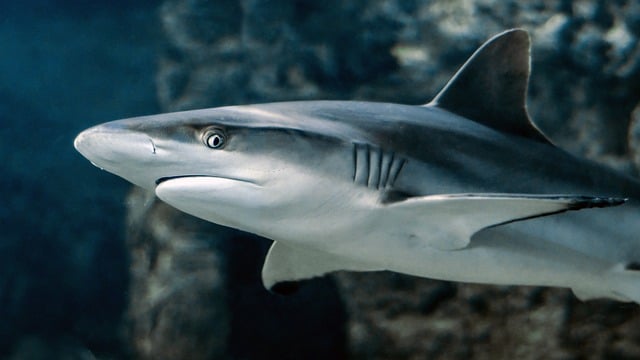
Sandbar sharks go by a variety of names, including thick-skinned sharks and brown sharks.
It is one of the largest sharks that regularly visit the beaches in Virginia. Sandbar sharks belong to the group of the world’s biggest coastal sharks. At maturity, they can be 8.2 feet long, with females being larger than males.
The Sandbar shark typical inhabits shallow waters, including ports, coastlines, and beaches.
They will occasionally swim out to water about 600 feet deep.
Virginia Beach is one of the best places to spot young sandbar sharks.
2. Smooth Dogfish Shark
These huge sharks have numerous names, including smooth dogfish, smoothhounds, smooth dogs, and dusky smooth dogfish.
One of the largest sharks near Virginia beaches is the smooth dogfish. The smooth dogfish shark can grow to a maximum length of about 5 feet.
Additionally, coastal sharks have different resources than deep-water sharks. Therefore, sharks residing in shallower waters can never reach large sizes like that of a great white shark. The diet of the smooth dogfish includes food from these shallow waters as well.
Moreover, the smooth dogfish’s row of blunt teeth is one of its distinctive features. They can crush and grind their food thanks to their special teeth.
3. Sand Tiger Shark
The sand tiger shark is one of the largest sharks residing close to Virginia beaches. However, it may still venture into shallower waters on occasion. If a shark is famous for its aggression, it’s the tiger shark.
However, as this results from instinct, they are not incredibly dangerous animals. Attacks are still not very common. And tiger sharks are important for maintaining the ecology.
Tiger shark adults can grow to be more than 14 feet long. They can have a more varied diet than any other shark due to their big size.
Tiger sharks may consume anything, including seals, dolphins, and birds. Furthermore, they also go by the name “trash eaters.” It’s because they frequently have rubbish in their guts, which is sadly prevalent in our beautiful oceans.
4. Bull Shark
Bull shark sightings are infrequent in Virginia since they prefer the vast oceans. Their inclination is primarily because the deep waters there allow them to grow. They still stop by the coastline on occasion, though.
Moreover, they rank high among the largest sharks around Virginia beaches.
Bull sharks may not be a frequent sight at most Virginia beaches. However, it might be for the best as they are notorious for their aggressive habits.
Furthermore, the bulk of bites occurring in coastal locations are due to them. They only grow to a maximum length of about 11 feet. One female, though, was measured at precisely 13 feet long.
5. Spinner Shark
The spinner shark is a deep-water shark and can survive in 330-foot-deep waters. Although it favors visiting shallow coastal waters, it is an occasional visitor to Virginia beaches. Its look is comparable to that of the blacktip sharks.
Spinner shark sightings, although not common, are becoming more frequent. This is a result of their propensity towards hotter climates, such as those in South America.
Some spinner sharks also live in Virginia’s southeast shore. When the time comes for pups, spinner sharks occur most prevalently in this region. Additionally, spinner shark pups are often cared for in shallow nursery areas like bays.
6. Atlantic Sharpnose Shark
The Atlantic sharpnose shark can grow up to 4 feet long. It is among the largest sharks that are frequently found nearby Virginia beaches. Their name comes from their distinguishing feature: the pointed nose.
Its populations are currently prospering in both the Gulf of Mexico and Atlantic Ocean and it exceeds expectations by a wide margin. However, regulations are necessary to ascertain the long-term survival of the Atlantic sharpnose.
For coastal sharks, the Atlantic sharpnose shark’s diet is around average. They consume shrimp, eels, crabs, mollusks, and tiny fish.
7. Dusky Shark
Requiem sharks include the dusky shark, which are significantly bigger in size. The dusky shark can grow to a maximum length of 14 feet – the length of an average car. Additionally, they are capable of weighing up to 800 pounds, making them one of the largest members of the Carcharhinus genus of sharks.
The Dusky Shark was once regarded as endangered, resulting from their relatively long gestation periods and slow maturity. They are, however, also well-liked amongst fishermen who like to harvest them for their oils and fins.
Overall, people are not at great risk from dusky sharks. However, you should exercise caution near them because there have been a few documented attacks involving them due to their size.
8. Blacktip Shark
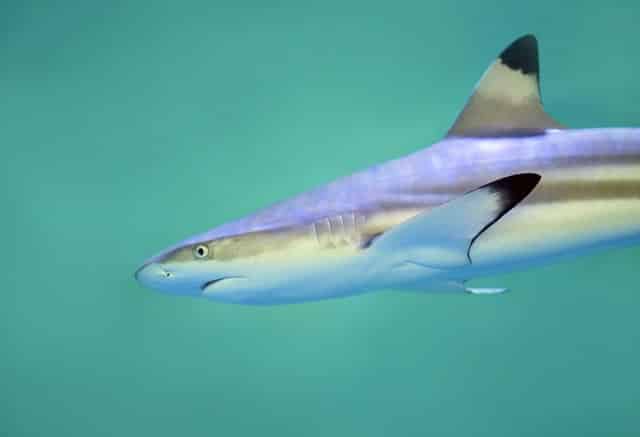
The name of the Blacktip shark derives from the distinct black tip on each of its fins.
It is another type of requiem shark. As a result, it is somewhat related to the dusky shark and the sandbar shark. The blacktip shark is substantially smaller compared to the dusky shark, though.
The blacktip shark normally reaches an adult length of about 9 feet and can be quite aggressive. Additionally, numerous assaults have been recorded.
The blacktip shark is not considered “bad” because of this. It simply indicates that you might not want to swim with one as you would with other sharks.
9. Scalloped Hammerhead
Another massive shark found along the Virginia beaches is the scalloped hammerhead shark. Although it it’s one of the biggest in the area, it’s one of the smallest hammerhead sharks, with a maximum length of 8.2 feet.
However, some scalloped hammerhead sharks have grown to over 10 feet in length! You probably won’t see it close to Virginia’s coasts for most of the year.
In fact, it’s unlikely that you’ll frequently see them close to any coasts. They prefer deep-water oceans and live and prosper there. They will, though, go inland to take advantage of the shoals during the breeding season.
Furthermore, the metabolic rates of scalloped hammerhead sharks are high. It implies that they may require more food than certain other varieties of sharks.
10. Smooth Hammerhead Shark
The smooth hammerhead has a maximum length of 16 feet. Despite its size, it is a more frequent coastal find.
However, the majority of smooth hammerhead sharks are content to eat small fish. Some of the largest have been observed eating rays and other sharks. Additionally, they may be dangerous to people due to their humongous size.
There have reportedly been some attacks, but generally they prefer to avoid humans, just like all other sharks. Sometimes they are observed swimming close to piers and fishing locations.
Moreover, they plunder fishermen’s catches. It has a vulnerable species designation.
Shark Bites
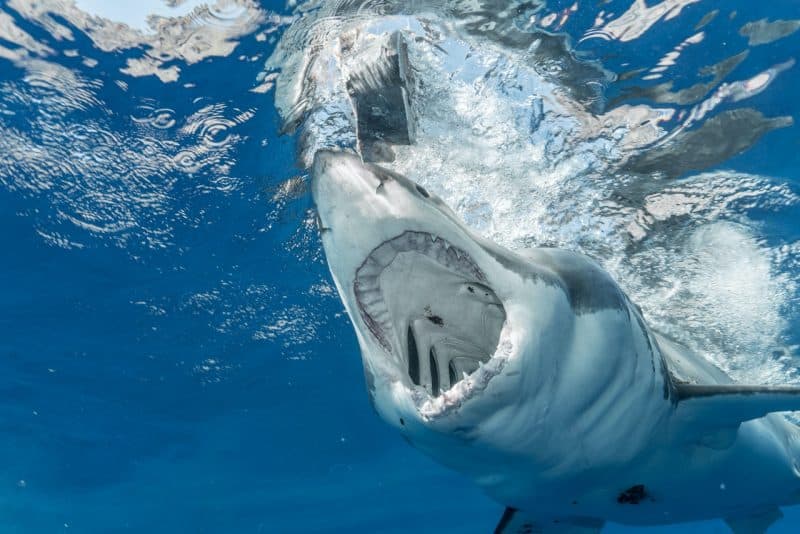
Provoked Bites
When a person initiates contact with a shark in some way, it is called a provoked bite. These include situations where people bother or approach sharks.
While releasing a shark caught in a fishing net or hooked, bites can happen. Furthermore, the shark exhibits defensive behavior in these interactions. Attempts to feed sharks have resulted in many incidences of human bites.
Unprovoked Bites
These are instances where a shark bites a person in the animal’s native environment. Additionally, humans did not provoke the shark in any way.
These are the shark behaviors that are in accordance with their instinct and are the data types that we utilize most frequently for study. On the ISAF website, all publicly accessible data comes from unprovoked incidents.
Hit & Run Bites
It occurs close to beaches when sharks try to catch fish to survive. Strong surf and currents and unclear water can all contribute to a shark misinterpreting human movements.
The shark makes one grip, releases it, and then swims away. Moreover, they bite feet or legs frequently. Most injuries are minor, with fatalities being uncommon.
Sneak Bites
Deeper seas are where it happens. The shark is not visible to the victim before the encounter. Therefore, the outcome could be a fatality or severe injuries.
Bump Bites
A bump-and-bite occurs when a shark deliberately bumps into its target before attacking and biting. Additionally, the shark may bite multiple times in a sneaky manner, which can result in serious injuries or even death.
Incidents Due to Shark Attacks in Virginia Beach
Additionally, statistics suggest there have been about 1,100 shark attacks from 1837 to 2014, reported across the country on all coasts. Here we will discuss some cases of shark attacks in Virginia.
In Virginia, the first documented shark attack occurred in 1852. A shark killed a deserter who was leaving the USS Pennsylvania by swimming.
In Virginia waters, there were 19 shark attacks between 1900 and 2020. Four of these had fatal casualties. Additionally, some attacks were instigated. For instance, when a blacktip reef shark was revived from anesthesia, it bit the worker.
The deadliest attack in Virginia occurred in 2001. A 10-year-old boy swimming in the ocean near Sandbridge was bit by a bull shark.
The most recent attack took place at Sandbridge in 2010, which was not lethal but startling. An 18-year-old surfer was bitten on the knee and ankle by a shark.
Famous Shark Attack Cases

Three swimmers were attacked by sharks in Virginia over the Labor Day holiday in 2001. It caused two people to pass away and severely injured the third. Furthermore, the victims in both fatalities lost a lot of blood before passing away.
Sharks were responsible for similar disasters decades ago in the two Atlantic states. In Florida earlier that year, a bull shark tore 8-year-old Jessie Arbogast’s arm off. They found his limb and attached it again.
Off Oak Island, in waist-deep coastal waters, two teens were attacked separately by sharks late on a Sunday afternoon. They were about two miles apart, which would take around 90 minutes to reach one other.
Both of them lost an arm, and one also lost a leg. However, they could not capture the participating sharks. Experts believe that wound details would reveal the species and size of the sharks.
Advice to Avoid A Shark Attack

In every endeavor, risks should always be kept to a minimum. These pieces of advice can help decrease your chances of coming into contact with a shark:
Always go with a friend. Sharks are more likely to advance toward a lone individual. Don’t stray too far out from the coast since you become cut off from emergency assistance when too far from the beach.
Avoid going into the sea at dusk or dawn. Additionally, many sharks are most active at night when feeding. Keep yourself away from known sport fishing sites that have effluents. Plus, seabirds that dive are reliable signs of a shark’s presence.
Don’t swim in water that is used by fishermen. Additionally, dolphin sightings won’t guarantee that sharks are not present as they frequently consume the same foods.
Moreover, when the water is murky, maintain extra caution. Some shark species will struggle with vision just as much as you do. Avoid wearing brightly colored clothing or swimming with an uneven tan because sharks have fantastic contrast perception.
If you want to read more about Sharks we have a few articles for you!
Can The Risk of Sharks Attacks Be Eliminated?
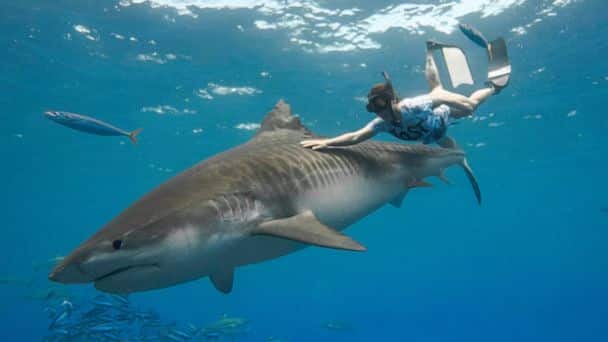
It is impossible to eliminate the possibility of shark attacks. Shark exclusion nets create a wall between sharks and humans, and they cause the environment the least amount of harm. However, these nets aren’t entirely successful.
Moreover, sharks and other marine animals can become entangled in them and die. Furthermore, operating them costs a lot of money.
Only low-energy (non-surf) zones are suitable for them. People and businesses use modern technology to keep an eye on sharks, employing sensor buoys or drones.
Consequently, you can manage maritime hazards at public beaches. Hopefully, these innovations will lead to safer solutions for people and animals.
Are All Sharks a Threat to Humans?
Research suggests that only about 6% of sharks tend to bite humans. Among them, just a dozen or so are potentially harmful. Additionally, numerous shark species in Virginia have bitten people, including the tiger shark, the white shark, and the bull shark.
However, all sharks—big and small—are predators. If provoked, they may cause injuries. When you come across them, you should treat them with caution.
The Final Say on Shark Attacks in Virginia
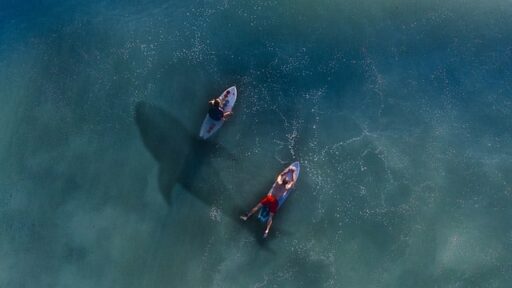
Virginia is a very famous tourist attraction in the US. A large number of travelers go there to enjoy its beautiful beaches every year.
However, there has been a rise in shark attacks along its beaches because a large number of mighty sharks are present there. Many shark sightings just off its coast occur from time to time.
Virginia waters are home to the most aggressive sharks in the world. There have been many serious attacks resulting in casualties. So, if you ever visit Virginia beaches, beware of these hidden mighty predators.
Thank you for reading about Shark Attacks in Virginia. If you want to read more about shark attacks also have a look at Shark Attacks in New York, Shark Attacks in California or Shark Attacks in Florida.
- Magpie Bird Is Reunited with Her Dog Best Friend - April 24, 2024
- Dog Saves Another Dog From Drowning in Fish Pond - April 23, 2024
- Man On Motorbike Rescues Cat From Highway - April 23, 2024

